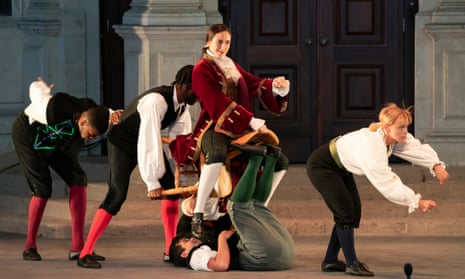This was the first opera from the new period-instrument ensemble Figure, and it was billed as a semi-staging, a description that did no justice to Sam Rayner’s production. Who needed sets, when Rayner effectively had six pieces of human scenery to play with? And play is the word: these six actors and acrobats moved in often mischievous ways, constantly changing the space and the energy around the singers. One moment they were obsequious courtiers, then they were forming themselves into a horse on which King Xerxes went riding, then they climbed on each other’s shoulders to become the plane tree, the unlikely subject of the king’s glorious first aria. Later, out came a unicycle and a tightrope, and they were a private circus representing the desperation with which he was trying to impress poor Romilda. It was fantastically detailed stuff, intrinsic to the storytelling.

This wasn’t a full performance of Serse: a lot had been cut, including the subplot involving the jilted Amastre, and while most Handel operas thrive on a degree of red pencil this felt a little drastic, adding glitches into the musical flow and presenting an even slighter story than the one Handel set, and one that needed its ending tweaked to couple Xerxes up with a different woman. And so the Xerxes of the impressively secure-sounding, mellow-toned US mezzo-soprano Cecelia Hall ended up not with the absent Amastre but with Anna Cavaliero’s sweet-voiced but scheming Atalanta. Meanwhile, Sarah Tynan and James Laing made stirring and at times touching work of the music for the “genuine” couple, Romilda and Arsamene.
Figure’s founder, Frederick Waxman, conducted from the harpsichord. It’s a young orchestra, albeit with a few more seasoned players, and a lack of long operatic experience perhaps showed in a few messy corners, compensated for by the consistent buoyancy of the playing. All this had been put together for only one performance, borrowing Opera Holland Park’s theatre on what would have been a dark night – but Figure clearly has good ideas, good musicians and good support, so expect to see more of them.

Comments (…)
Sign in or create your Guardian account to join the discussion